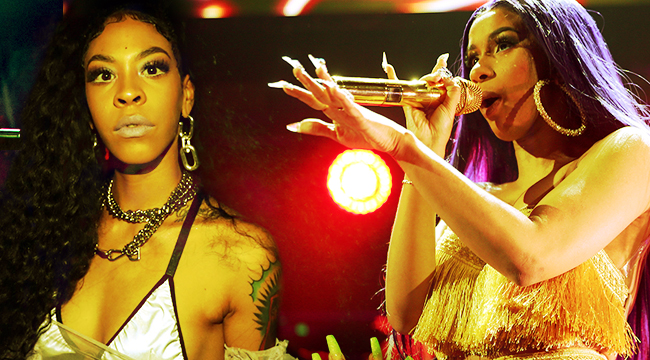
When I was a kid, I owned a copy of Heather B’s final album, Eternal Affairs, on CD and basically wore out the disc listening to it on the bus to and from school. For years after, I wondered why Heather B never put out another album after that. Nor did, after a certain point, very many major label female rappers. I saw this as a huge problem.
See, I was a hyperactive kid with attention deficit and I got bored easily. I also asked a lot of questions, such as: If women are half the population, why are they much less than half of the voices in mainstream rap? I loved hip-hop, but it needed even more variety to keep me invested and to me, the most logical place to mine for new material should be the minds of women, who could bring new stories and perspectives to the art form. Later, I’d meet other friends — some of whom were rappers themselves — who would share this viewpoint.
Today, 15-year-old kids riding the bus to school — or perhaps taking a Bird or an Uber — don’t lack for options. An increasingly diverse array of voices, perspectives, and styles are filling their Apple Airpods with an entire galaxy of female rap stars, offering their takes on everything from dating to motherhood to business advice.
This is how it should be, but it took a lot longer to get here than it should have. In honor of International Women’s Day, we’re going to take a look at just what cultural and societal changes had to happen to clear the way for women to take their rightful place at the forefront of rap. Whether it was representation, technological advancement, more opportunities, or shifting mindsets, so many elements contributed to this moment in time. Here’s hoping it continues and conditions for women in every culture and industry continue to improve.
Nicki Minaj And Cardi B Paved The Way
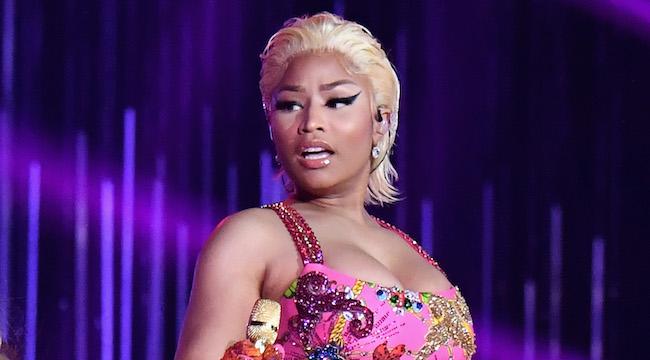
One of the reasons attributed to the apparent dearth of female voices in rap through the 2000s is the idea that so few young girls wanted to rap. Hip-hop was seen as a man’s game, so women had no interest in playing. Now, we understand that to be a fallacy. Even at its lowest point, rap still had plenty of women, but it is true they were given fewer chances to succeed and even fewer to fail.
Rappers like Jane Doe and Rah Digga got shelved, Shawnna got overlooked, Ebony Eyez was obscured, and it’s likely that to many young girls, their remaining would-be role models didn’t seem aspirational, since so much of their success seemed to hinge on their appeal to the male gaze. Jacki-O and Trina may have been fun to listen to, but playing up their sex appeal probably wasn’t very appealing to teen girls who would have already felt judged and insecure.
That all changed with the arrival of Nicki Minaj, who for nearly 10 years, ruled the rap landscape with an ironic fist and a multiplicity of personalities and flows, once again showing that you didn’t only have to rap about sex, since her rhymes ran the gamut from cultural pride (she has roots in Trinidad) to therapeutic reminisces on her rough childhood. She may have played up her physical attributes at times, but she also simply played, with her voice, with her roles, with her clothes, her makeup, and her passion. That representation likely inspired the current upcoming generation of aspiring rappers, in whom her musical and aesthetic DNA is readily apparent. Just check out how many up-and-coming MCs are named “Doll,” a clear reference to Nicki’s supremacy as “Queen Barb.”
Then, with Cardi B appearing on the scene to dominate in 2017 and ripping off an unprecedented and historical run that included Grammy nominations and wins, performances on just about every major stage, record-breaking sales and radio success, plus dozens of endorsement deals and sponsorships, young women had more than one completely dominant personality to look up to. When the two women were pitted against one other, yes, some in their respective fanbases chose sides, but others rightly called out the entertainment industry for doing so. Their physical altercation aside, they showed that multiple women can coexist, an idea buttressed by peripheral examples like Iggy Azalea and Rapsody, who both achieved degrees of similar success, while also providing alternative presentations for future rappers to emulate.
Women Were Able To Leverage Technology To Get Around The Labels
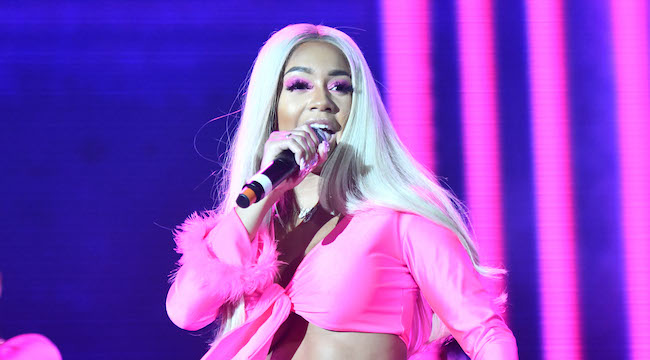
For years, the only way to achieve any serious success in the industry was to sign to a major label. The problem in the 2000s, at least according to trade scuttlebutt, is that labels didn’t want to take the “risk” of signing female artists outside of a few, surefire, established names. The prevailing wisdom is that women require more investment than men, with dedicated stylists and glam teams to keep up their appearances, versus a lower threshold for interest from the presumably male-dominated rap fanbase. Now, we all know this was, again, a fallacy, but there is still no cure for deep-seated, misogynistic “common sense.”
However, in recent years, events have shown that it’s not only possible to do it yourself, it’s probably more desirable — for a while, at least. The explosion of artists building viable movements on Soundcloud is evidence for this, but for the new wave of women opening doors for themselves and others in hip-hop, probably the most vital tool outside of streaming has been Instagram.
Just look at Saweetie, who leveraged the online photo and video album to turn her freestyle over Khia’s “My Neck, My Back” into a mega-viral hit of her own, “Icy Grl.” From BbyMutha to Dreezy, City Girls to Rico Nasty, Coi Leray to Kodie Shane, Doja Cat to Princess Nokia, and Kash Doll to Tink, female rappers are able to use their social media platforms to stay connected to an engaged fanbase and activate them when necessary to fuel huge sales pushes.
Cardi B regularly trades witticisms with her fans on Instagram Live, while Nicki uses Twitter to promote new singles, videos, and her Queen Radio show. Princess Nokia called out a bigger star for perceived plagiarism and immediately received support from her devotees to call for accountability. Cupcakke’s life may possibly have been saved by a digital cry for help on Twitter, and Lizzo’s fans alerted her to a lyrical homage in a new Marvel Comic, helping them to feel like a part of her narrative. Doja Cat’s major label debut was largely overlooked, but then “Mooo!” took off to the far corners of Twitter and Instagram, making her a household cause celebre practically overnight.
https://www.instagram.com/p/BjYWsUtgpsJ/
Social media does the work major label marketing departments didn’t want to for years and because of the behind-the-scenes nature of these interactions, these women didn’t need to wear their highest heels or primp for an hour in the mirror. In fact, some of their most genuinely crowd-pleasing moments have been the raw, stripped-down, Instagram Live “girl talks,” where they often appear bare-faced and wigless, letting their fans feel more like close friends, endearing themselves to those watching.
Brand Partnerships Allow Them To Circumvent The Need For A Label Budget
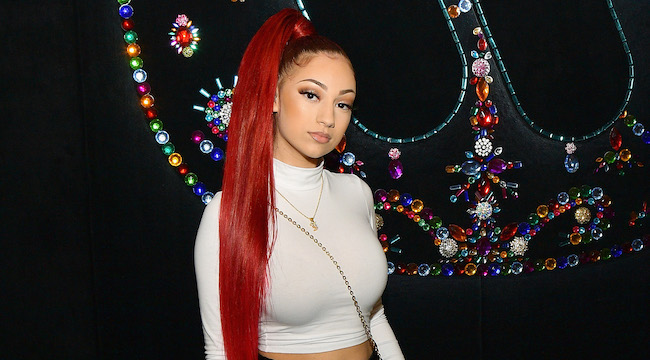
Dovetailing with their social reach, women in hip-hop are now able to cultivate brand partnerships thanks to these followings, generating cash that modern record deals often withhold. Why go to a label for a marketing budget when you can self-fund your debut album with a Fashion Nova sponsorship?
Kamaiyah and Wondagurl are just two of the faces to grace their own cans and commercials for Sprite, deals which offer them both more visibility and likely a more equitable split than the pittances offered by most major label contracts. Nicki Minaj regularly made the annual Forbes Hip-Hop Cash Kings list at the height of her reign, even after taking a break from recording that lasted from The Pinkprint in 2014 to Queen in 2018, largely because she was able to secure appearances in Pespi ads and a lucrative Mac makeup deal.
Licensing Their Music Exposes Them To Greater Audiences
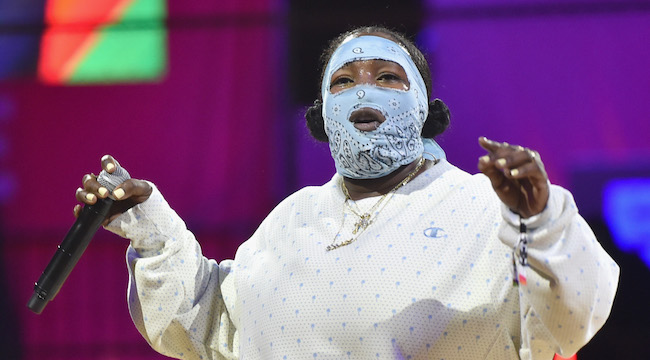
Music sales have always been only part of the picture. One of the lesser recognized but no less vital ways recorded music makes money for artists (or at least the rights holders) has been to license it for use in advertising, films, and television. This is how Little Simz began to gain a foothold with American audiences, manyof whom were first introduced to her extensive body of work through an 2016 iPhone commercial using her song “Wings” off the album A Curious Tale of Trials + Persons. Dej Loaf promoted her 2017 anthem “No Fear” with a placement on an episode of spiritual drama Greenleaf. Coi Leray appears on the Spider-Man: Into The Spider-Verse soundtrack on the song “Save The Day.” Dreezy’s “Body” pops up in an episode of Atlanta, while Dreezy herself plays a role on BET’s serial remake of Boomerang.
Television geared directly toward the ideal market of young Black women has proven especially fertile ground for planting the seeds of a grassroots support base. With show creator Issa Rae curating the soundtrack for her breakout romantic comedy Insecure, a larger stage has been provided for rappers like Cam & China, Kari Faux, and Rico Nasty. The show also shares a common link with young adult college sitcom Grown-ish in the form of masked rapper Leikeli47, whose hit “Money” has graced shows and film trailers all year and who debuted her video for “Tic Boom” in a recent episode of the show as part of the weekly plot.
Hip-Hop’s Gender Dynamics Have Shifted
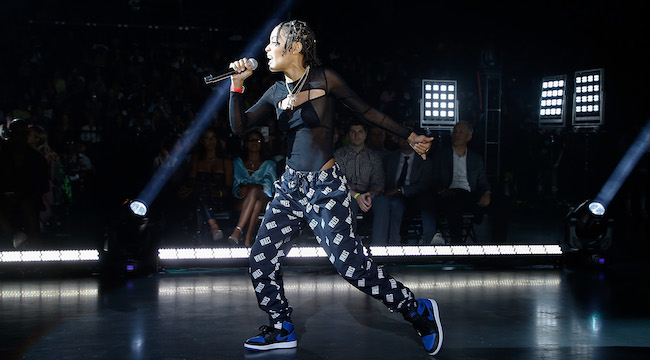
Whereas in the 1990s and 2000s, masculinity was defined by a more rigid set of acceptable behaviors and traits — mainly combative aggressiveness or cool stoicism — nowadays, thanks to the advent of social media and the shared bonds and communities it fosters, we recognize more expressions of gender identity.
Boys can be soft. Girls can be hard. Being unsure is okay. Navigating the world has become a tiny bit easier with the reassurance that none of us are alone. Tyler The Creator and Frank Ocean, two of pop culture’s most prominent examples of hip-hop success, both openly date men and participate in drag balls.
It’s no wonder then that more boys can feel comfortable mooing it up with Doja Cat or raging alongside Rico Nasty at shows or that Tierra Whack can be appreciated for not catering to the whims of a dated system that only values rappers in bikinis and short skirts. Boys and men can happily scream along to the lyrics of Queen Key’s Eat My Pussy without nervously glancing around to see if they’re being judged.
Hip-hop has always reflected the greater culture around it, but it’s also been a guidepost for it and at times, a pioneer bushwhacking the path ahead. The fact that there’s room for a Young MA, Kodie Shane, or Coi Leray, with their nonbinary presentation, means that society at large is moving in a more positive direction where self-expression is valued instead of stifled, which can only lead to even greater creative variety as more aspiring artists branch out into their identities.
There Is Greater Solidarity Among Female Artists
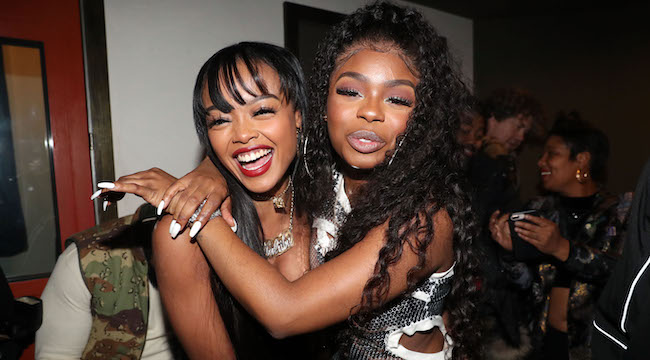
One of the main reasons it seemed women had such a strong foothold on rap at the turn of the century is because so many of them worked together. I’ve written before about “Ladies Night” and its embrace of sisterhood in the face of a male-dominated industry.
However, throughout the first decade of the millennium, it seemed like women were more wary of working together, perhaps nervous about being pigeonholed into their own separate lane of rap when they wanted to compete with the men too.
Now, though, with artist resources like Tunecore keeping track of streams provided by Apple Music, Soundcloud, and Spotify, they don’t need to worry about pigeonholing. If they want to work with each other they can, and now, they all benefit, even if they do get put in a separate box marked “female rappers.” There are enough ways to touch fans and generate revenue that those bonds of sisterhood can flourish again, to say nothing of the nearly nonstop stream of compliments and banter they trade via their social media pages.
For instance, Atlanta newcomer Young Baby Tate’s debut album Girls features nothing but other women, from fellow Atlantans Baby Rose, Killumantii, and Mulatto to BbyMutha to Kari Faux. Doja Cat and Rico Nasty are currently making waves with their ode to the female form, “Tia Tamera.” Dreezy and Kash Doll showed significant chemistry on “Chanel Slides.” While female rappers have always done this in some capacity — check out Rapsody working with everyone from Ill Camille to Jean Grae to Rah Digga — it’s become way more fashionable to make those collaborations part of the marketing as singles and videos rather than bury them in tracklists.
There’s never been a better time for women in hip-hop, as every day, more and more names throw their hats into the ring to vie for a spot in rap’s heralded pantheon of greats. The gateway may be more crowded than ever now, presenting its own challenges, but all the names mentioned above have never had a better opportunity for success than now, along with their burgeoning cohort including 3D Na’Tee, Baby Goth, Bali Baby, Cuban Doll, Jean Deax, Lady Leshurr, LightskinKeisha, Lil Brook, Maliibu Miitch, Megan Thee Stallion, Molly Brazy, S3sni Molly, Tokyo Jetz, Tommy Genesis, and more. Hip-hop isn’t just a men’s sport any longer and it’s all the better for it. Happy Women’s Day.
Some artists mentioned are Warner Music artists. .






